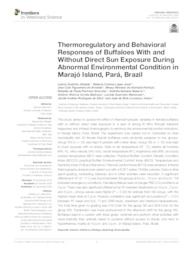Thermoregulatory and Behavioral Responses of Buffaloes With and Without Direct Sun Exposure During Abnormal Environmental Condition in Marajó Island, Pará, Brazil.
Thermoregulatory and Behavioral Responses of Buffaloes With and Without Direct Sun Exposure During Abnormal Environmental Condition in Marajó Island, Pará, Brazil.
Author(s): ATHAÍDE, L. G.; JOSET, W. C. L.; ALMEIDA, J. C. F. de; PANTOJA, M. H. de A.; NORONHA, R. de P. P.; BEZERRA, A. S.; BARBOSA, A. V. C.; MARTORANO, L. G.; SILVA, J. A. R. da; LOURENÇO JUNIOR, J. de B.
Summary: This study aimed to assess the effect of thermal-hydraulic variables in female buffaloes with or without direct solar exposure in a year of strong El Niño through behavior responses and infrared thermography to reinforce the environmental comfort indicators, in Marajó Island, Pará, Brazil. The experiment was carried out in Cachoeira do Arari municipality and 20 female Murrah buffaloes were randomly assigned to two groups: Group WS (n = 10) was kept in pickets with native trees. Group NS (n = 10) was kept in crush squeeze with no shade. Data on air temperature (AT, °C), relative air humidity (RH, %), wind velocity (WV, m/s), rectal temperature (RT), respiratory rate (RR), and body surface temperature (BST) were collected. Practical Buffalo Comfort Climatic Condition Index (BCCCI), practical Buffalo Environmental Comfort Index (BECI), Temperature and Humidity Index (THI) and Benezra's Thermal Comfort Index (BTCI) were obtained. Infrared thermography analysis was carried out with a FLIR T-series T640bx camera. Data on time spent grazing, ruminating, idleness, and in other activities were recorded. A significant difference in AT of ~1°C was found between the groups at 6 a.m., 10 a.m. and 6 p.m. THI indicated emergency conditions. Female buffaloes were at danger PBCCCI conditions at 2 p.m. There was also significant difference for RT between treatments at 10 a.m., 2 p.m. and 6 p.m., whose values were higher (P < 0.05) for animals from NS Group, with the highest mean time at 2 p.m. Pearson correlation was significant and positive (P < 0.01) between RT mean and VUL, TI and ORB mean, maximum and minimum temperatures. The total time given to grazing was 518.2 min for the group NS and 629.5 min for the group WS. Rumination was more pronounced in the afternoon shift for the group NS. Buffaloes kept in a system with trees graze, ruminate and perform other activities with more intensity than animals raised in systems without access to shade, and tend to hyperthermia, mainly at 10 a.m. and 2 p.m., in Marajó Island, Pará, Brazil.
Publication year: 2020
Types of publication: Journal article
Unit: Embrapa Eastern Amazon
Keywords: Búfalo, Conforto ambiental, Termografia
Observation
Some of Embrapa's publications are published as ePub files. To read them, use or download one of the following free software options to your computer or mobile device. Android: Google Play Books; IOS: iBooks; Windows and Linux: Calibre.
Access other publications
Access the Agricultural Research Database (BDPA) to consult Embrapa's full library collection and records.
Visit Embrapa Bookstore to purchase books and other publications sold by Embrapa.

